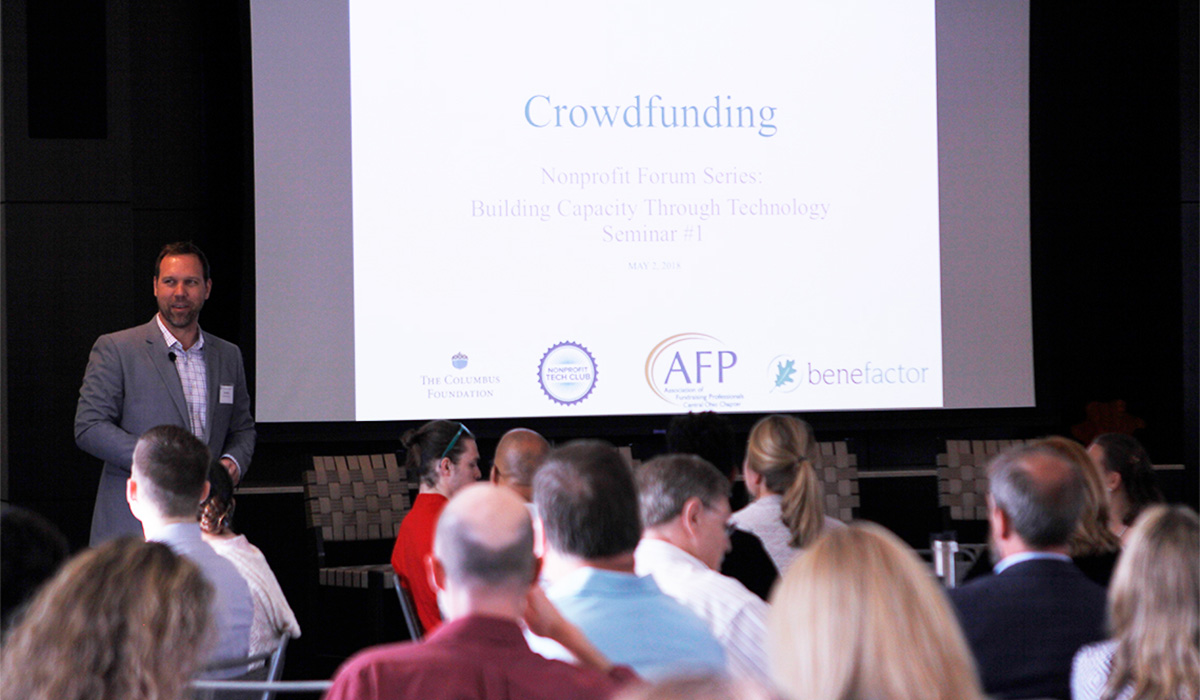13 Takeaways from a Crowdfunding Forum:
Recently, four panelists shared great advice on crowdfunding at the Building Nonprofit Capacity Through Technology Forum at the Columbus Foundation. The panelists were:
- Megan Murphy, Digital Fundraising Specialist, The Ohio State University Alumni Association
- Jen Patterson, Director of Development & Communications, Harmony Project
- Elissa Schneider, Director of Major Gifts, Mid-Ohio Foodbank
- Zack Brown, Founder, PotatoStock Festival, and Author, The Peace, Love & Potato Salad Cookbook
- Moderated by J.D. Beiting, Benefactor Group
The 13 key crowdfunding forum takeaways that stood out can be applied to four categories: Donor Stewardship, Technology Management, Story Telling, and Start Simple.

Donor Stewardship:
- Grow the bottom of your pyramid. When asked, “Why do you crowdfund?”, one organization saw it as a great way to feed the donor pipeline with new supporters. Of course, many of the people that give via crowdfunding won’t renew (and that is okay), but some will. And, through disciplined follow-up and donor-centered communication, some of those people can become meaningful supporters.
- Don’t forget to follow through. Call it crowdfunding, but it’s still good old-fashioned fundraising and it requires follow-through and stewardship. Keep any promises you make and be sure to say thank you in a meaningful way–like saying their name out loud while you record yourself making potato salad, for example. Or, if that doesn’t exactly work for you, maybe you ask participants to take pictures and then share them with others.
- Send hand written notes. What a great way to make personal the highly digital style of crowdfunding.
- Get permission. After someone gives a first gift, give them the option to opt out.
Technology Management:
- It’s a waterfall, be prepared. Zach, who has a programming background, related crowdfunding to his experience with two approaches to software development. Agile: meaning you do a little bit, learn, adjust, change, and then do a little bit more; and Waterfall: you do one step after another, in order, to a predetermined destination. Crowdfunding is waterfall. Once you put a program out there, you are committed to deliver on the promise. Plan accordingly.
- Who will own your data? Kickstarter owns the data they collect. Is that okay for your donors? Think this through and be sure you are comfortable with who has access to the data and how they might use it.
- There are too many technology options to count.D., from Benefactor Group, shared a slide that must have had 30 different products that “do crowdfunding.” Resist the urge to buy the shiny thing. Write your requirements and do your due diligence. Spending an extra few hours might save you dozens of hours (and some heartburn) down the road.
- We have great local options for crowdfunding tools. The Columbus Foundation provides two tools: The Giving Store and Better Together, at no cost to use and low credit card processing fees. It’s easy to set up, it’s free, it sends the receipt, and you have online access to your donor data.

Story Telling:
- It’s all about the story. Elissa from the Mid-Ohio Foodbank talked about how they take a crowdfunding initiative, like Giving Tuesday, and create a related story. In their case, it was, “This is Tuesday for a hungry person.”
- I want a thousand Marthas. Find the people that personify your ideal constituents. Contact them, get their feedback, and use their words as you plan and promote your next efforts.
Start Simple:
- Add it to something that is already happening. You don’t have to look at a crowdfunding effort as a standalone project. Instead, consider connecting it to something you are already doing. For example, if your volunteers already do an annual fundraising event, consider adding crowdfunding to it.
- To get buy-in, do a pilot. Maybe not everyone in your organization sees the value of (or even understands) crowdfunding. So, do something small. Do a low-cost pilot and illustrate the outcome.
- Ask and listen, learn about your audience. Don’t guess what sort of efforts might speak to your constituents, ask them. Then, using that feedback, test a small initiative, learn, adjust, and improve it.
Finally, a big thanks to The Columbus Foundation, AFP Central Ohio, NTEN, and the impressive panelists. Join us on August 15th for the next Session about Being a Data Driven Nonprofit. For more information, email Steve Beshuk.
For more information, stay tuned on our blog.





